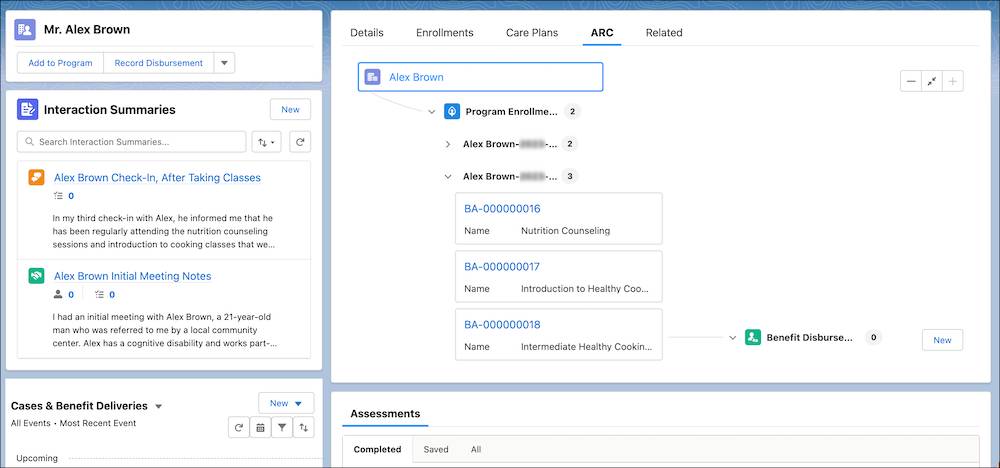Meet Nonprofit Cloud for Programs Case Management
Learning Objectives
After completing this unit, you’ll be able to:
- Explain how Nonprofit Cloud for Programs can help your team drive participant outcomes and collaborate.
- Recall the case management tools included with Nonprofit Cloud for Programs.
- Describe how case management and program management features in Nonprofit Cloud for Programs work together.
Case Context and Collaboration for Complete Client Care

Let’s talk about caseloads.
How many cases is each case manager at your organization actively working on? How many program participants and other contacts does that include? Now think of the tasks around each of those cases—the intakes, the assessments, the notes, the referrals.
Dizzying, right?
If your nonprofit provides hands-on, long-term support for the people you serve, you know the strains of administrative workload, disconnected systems, and a lack of visibility into a participant’s complete circumstances.
In this badge we review a Salesforce solution that can help: Nonprofit Cloud for Programs’ case management features. (If you haven't already learned about Nonprofit Cloud for Programs, start with the Nonprofit Cloud for Programs: Quick Look module.)
These integrated Salesforce features are designed to drive better participant outcomes. They help program teams understand the full context of every participant, deliver individualized care, and collaborate to deepen support.
Explore Case Management Tools
From intake to outcomes, Nonprofit Cloud for Programs helps you manage the entire case management lifecycle with customizable tools and features.
Your inbound referrals and intake process can be set up as a guided flow to help for a consistent experience for your staff and your clients. Intake flows can include dynamic assessments that enable you to answer the most relevant questions, upload documents, and work at the speed of your participants and processes. These features are managed using the Salesforce Omnistudio and Discovery Framework tools. Check out the links in Resources to learn more about these tools.
After completing the intake process for a participant or group of participants, you use the Case object to plan your work together. Cases can span multiple programs. They can also include many individuals, such as the participant, the participants primary caretaker or family members, and support teams within your organization.
A case record connects to a care plan you use to track a participant’s goals and needs, and the programs, benefits, and tasks they use to meet those goals. Your team can start from care plan templates to save time and increase consistency, then customize where a participant has different needs. Then, as you work with your participant, you track their progress against the care plan—and get a historical view of their work on the timeline component on the care plan record.

You can record notes using interaction summaries. The Interaction Summary object in Salesforce gives your team the tools to capture notes about the participant and view the notes in chronological order to review your past work.
When the unexpected happens in a participant’s life, you can track incident details and follow-up tasks using the Complaints object. Complaints is the standard Salesforce object name. Work with your admin to change the label to something that matches your mission and processes, like Incidents or Alerts.
You can also refer participants to outside organizations and track their progress with the Provider Management data model. This model helps you build and track a network of external organizations—like nonprofits, government agencies, or healthcare providers—that have specialties that support your work. Match the benefits your organization wants to provide with the specialties of these external organizations to enhance your care plans and help participants achieve their goals.
All of the information you collect is brought together on Participant Profiles, which give you a complete view of a participant’s engagement. That profile includes helpful visualizations, such as:
- A timeline of their interactions with your organization
- A simple view of key life events
- And a map of their relationships with important people and organizations in their lives, like their family and employer
With this information about a participant in one place, anyone on your team can quickly learn about a participant’s needs and collaborate more effectively with other case managers. This data helps you provide participants with a greater level of care.
Check out the Stakeholder Management in Nonprofit Cloud module for more information about how people are tracked in Nonprofit Cloud.

Connect with Program Management Features
The case management features we just outlined automatically integrate with Nonprofit Cloud for Programs’ program management features and data structure.
You can enroll your participants in programs, sign them up for benefit schedules, and use attendance features as you need. Then, as you track benefit deliveries, those records automatically relate back to your participants’ cases, care plans, and account records. The dots are connected for you, giving you a single view of your work.
For more on those features, and other Nonprofit Clouds for Programs basics, check out the links in Resources.
Resources
- Trailhead: Nonprofit Cloud for Programs: Quick Look
- Trailhead: Omnistudio Basics
- Salesforce Help: Manage Every Aspect of Questionnaire-Driven Information Collection
- Trailhead: Stakeholder Management in Nonprofit Cloud
- Trailhead: Programs and Benefits in Nonprofit Cloud for Programs
- Trailhead: Attendance and Benefit Tracking in Nonprofit Cloud for Programs
- Trailhead: Provider Management Data Model in Public Sector Solutions
- Trailhead: Nonprofit Cloud Case Management Basics (Managed Package Product)
- Salesforce Website: Try Nonprofit Cloud free for 30 Days
